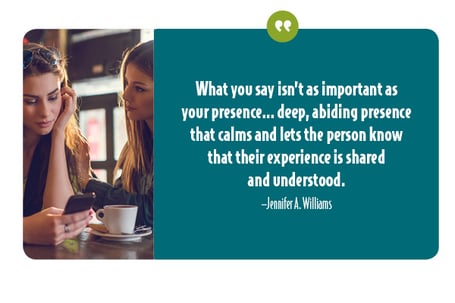The adage, “think with your head, not with your heart,” would make you think that emotional empathy (Part I of this series) and cognitive empathy (Part II of this series) cannot coexist. Luckily, that’s not true! When the heart and mind meet in the middle, the third type of empathy comes alive—Compassionate Empathy.
Estimated reading time: 5 minutes
What Is Compassionate Empathy?
Compassionate empathy is the antithesis of knee-jerk reactions.
It is often the ideal response to challenging situations as this skill blends intellect, emotion, and action by considering the whole person.
By developing compassionate empathy, you’ll go beyond a simple understanding of interactions, whether emotional or intellectual. You’ll be able to nurture a deeper connection with others and feel comfortable no matter what another person is sharing with you.
Compassionate empathy is the ability to understand and share in someone else’s emotions, but without taking them on as your own emotions or blurring the line between you and another person. This kind of empathy uses emotional intelligence to effectively respond to a situation without becoming overwhelmed or trying to fix anything.
Compassionate empathy empowers the other person to step into their own power and take action.
Whereas cognitive empathy may be the best response in intellectual debates and emotional empathy may shift into gear when it comes to our loved ones, compassionate empathy is what we at Heartmanity consider to be the ideal response to most situations. That’s because it considers the whole person.
Learning how to talk with someone and what to avoid takes practice.
Compassionate Empathy Considers the Whole Person
When we say that compassionate empathy “considers the whole person,” we mean that compassionate empathy:
- Aims to connect with the other person, see the world through their eyes, and understand their feelings without an overlay of your emotions.
- Focuses on the other person with gentle curiosity and without being attached to a specific outcome.
- Compassionately acknowledges and validates emotions without advising, unless requested.
- Creates a safe space for the other person to share and resolve their struggle.
- Helps to regulate the other person’s emotions and ground them into their inner strength and wisdom.
- Connects the person to their own heart and logic, which increases insight, meaning, and the courage to act.
Related reading: "The Three Kinds of Empathy: Cognitive, Emotional, and Compassionate."
Why It’s Vital to Remember You Don’t Have the Whole Picture
When we approach someone’s experience, it’s crucial to recognize that we rarely have all the facts. Each of us carries unseen stories, stressors, and personal histories that shape our reactions—much like the tip of an iceberg above the surface while everything else remains hidden below.
This awareness helps us extend compassion without jumping to conclusions or offering unsolicited advice. What appears to us as a simple overreaction or a puzzling emotional response may be the result of a sleepless night, personal loss, or prior experience that color their situation.
By staying mindful of these unseen factors:
- We can pause before making assumptions, allowing curiosity to lead instead of judgment.
- We will find it easier to listen—from a place of empathy rather than “problem-solver mode.”
- The support we offer will respect the other person’s unique perspective, without projecting our own mood, history, or current stress onto the interaction.
In short, understanding that we never have the full story invites humility. It cultivates a safe space for genuine connection and demonstrates the same grace we hope to receive when our own story is only half-visible to others.
 Compassionate vs. Cognitive vs. Emotional Empathy Examples
Compassionate vs. Cognitive vs. Emotional Empathy Examples
To illustrate, let’s examine a situation and the difference between responses built upon compassionate empathy versus responses centered on cognitive or emotional empathy.
Scenario:
Your best friend at work, looking distraught, comes to your desk and says, “Sam disrupted my presentation, and in front of the director! I don’t know what I’m going to do; I’m so furious. He always thinks he knows better. I just don’t see a way out—he micromanages everything!”
Empathetic Response Using Emotional Empathy
The Emotional Empathy Response:
You immediately feel the impact of your friend’s emotions. Your heart feels deeply for their situation—you’ve been there. You take your friend’s hand, saying, “You’ve got a right to be angry; that’s so disempowering and embarrassing!”
Empathetic Response Using Cognitive Empathy
The Cognitive Empathy Response:
You pull up a chair for your friend and say, “Walk me through what happened. That may shine a light on how best to proceed, and I’ll help you get there.”
Empathetic Response Using Compassionate Empathy
The Compassionate Empathy Response:
You ask your friend to join you on a walk outside. Once away from the office, you say, “I know how important that presentation was to you; you put a lot of work into it. That’s got to be so infuriating! And it sounds like you’re totally fed up with your manager.”
After your friend’s emotions settle, you say, “Tell me more about what happened and how you plan to handle it.”

All three responses foster a connection with the other person and help them on their return to serenity and to finding a solution.
However, the compassionate, empathetic response utilizes all three aspects of empathy while acknowledging the person’s whole experience. It provides a safe space for the other person to express themselves, feel heard, and regain their solid ground.
For more on how to talk to someone with empathy, check out "How to Talk to Someone with Empathy—and What to Avoid!"
Why Choose Compassionate Empathy?
Compassionate empathy is the middle ground that honors the natural connection between the brain and the heart.
As a result, there are very few drawbacks, if any, to feeling and expressing compassionate empathy for others! This type of empathy goes beyond merely understanding others and sharing their feelings. It moves us to act; to help wherever we can. It provides the groundwork for sharing experiences AND assists the other person in growing.
Being compassionate helps us be healthier overall, according to the Greater Good Magazine from the Greater Good Science Center at UC Berkeley. Greater Good writes that leading researchers in positive psychology suggest compassion for others helps speed recovery from disease, improves physical and mental health, and may even lengthen our lifespan.
Amazing benefits for our empathetic responses, wouldn't you say?!
How to Develop Compassionate Empathy: Step-by-Step Process
Like all types of empathy, compassionate empathy is a skill that can be developed and improved over time.
To strengthen your relationships with others, and find real solutions to problems, try these essential steps for expressing compassionate empathy:
STEP 1: Empty and calm yourself.
Make sure you have the mental and emotional space to be present before engaging.
Tip: Before you begin, remind yourself that you don’t have the whole picture. At any given time, a person is juggling countless factors you may not see. Approach with humility—your own thoughts and emotions might shift from day to day based on mood, stress, or outside influences.
STEP 2: Listen attentively.
Listen astutely when others are talking to you about a problem or how they feel. Compassion springs out of being present.
STEP 3: Suspend judgment.
A person will not feel understood if you are judging their feelings, how they are expressing themselves, or what they're saying. It’s easy to think they’re overly emotional or irrational in their conclusions. Don’t. Carve a safe space.
Before you engage with another person, consider what you already know about them, but be open to learning more. Our interpretations of others—how they feel, what they’re thinking—are often colored by our own experiences, biases and unconscious assumptions.
A smile can mean joy or exuberance, but it can just as easily mask sadness or embarrassment.
So, pause your inner commentary and refrain from jumping to conclusions or rushing to judgment. Let your curiosity and patience lead.
Remember: Under emotional stress, people (yourself included!) can react in ways they never expected. A little grace goes a long way—both for others and yourself.
STEP 4: Remain open and hold caring eye contact.
Display open and friendly body language. Maintain soft eye contact to help foster a deeper connection and trust.
As you listen, pay attention not only to what is said but also to subtle feedback, such as nonverbal body language, even subtle shifts in posture or tone. Being open means staying attuned to all these cues without immediately filtering them through your own lens.
STEP 5: Accurately mirror the emotions of the person.
The most crucial part of compassionate empathy is sensing the feelings of another person and reflecting their experience back to them compassionately. It's in this exchange that a person can relax into their heart and recenter.
Keep in mind that your first instinct about someone’s mood or emotional reaction might not be accurate. Take time to observe, listen, and reflect back what you see and hear, adjusting your understanding as you receive more information.
STEP 6: Validate the person.
When you understand how the other person feels, respond with statements indicating you understand. For example, "It sounds like that experience was very upsetting for you!" [or sad, exciting, joyful, satisfying, etc.] or "I can't imagine how difficult that must be for you."
Adapt your descriptive words based on their emotions and body language.
This validation in compassionate empathy is strengthened when you consider their feedback—whether it’s direct or through body language—and let it inform your responses so they feel truly seen and heard. When we pay close attention, we are able to be an accurate mirror and build resonance with the other person.
 STEP 7: Repeat the steps if the person's emotions escalate.
STEP 7: Repeat the steps if the person's emotions escalate.
You will know that the person feels understood when the emotions settle and dissipate. If they don't, you may have used feeling stoppers, such as fixing, denying, or changing the subject. Or you could have simply misunderstood what they were trying to convey. Try again.
Compassionate empathy is an ongoing practice. It can be helpful to practice the above steps one at a time until you feel competent in each.
Practicing these steps with openness and humility helps you build genuine connections and a deeper understanding—not only of others, but also of how your own communication style is perceived. These steps require increased self-awareness, self-control, and a combination of various EQ abilities.
The next time you’re struggling to see someone else’s perspective, pause and recall: we all have our own struggles, and a little extra compassion can make all the difference.

Frequently Asked Questions
Are compassion and empathy the same?
Compassion and empathy are related but distinct concepts. However, you could say that Compassionate Empathy (a kind of empathy) is the same as compassion.
Below are the primary differences. It's not so important that you distinguish them but instead focus on being kind and compassionate in your interactions. Both compassion and empathy deepen connections and help the person to feel heard and cared for.
Empathy is the ability to understand and share the feelings of others. It involves feeling what another person is experiencing emotionally and understanding their perspective to respond in kind.
Compassion recognizes someone's suffering and is moved to help alleviate that suffering. Compassion or Compassionate Empathy takes action to provide support and relief.
Empathy is more inward-focused (feeling the emotion), while compassion is outward-focused (desire to help). Empathy can be a momentary connection, whereas compassion often reflects a longer-term commitment to assisting others.
We could see empathy as a precursor to compassion. Compassion takes the understanding gained through empathy and translates it into a desire and effort to make a positive difference.
If you’d like an easy-to-follow practice guide to master compassionate empathy in your life, download Real Empathy, Real Solutions, and get your action plan to self-coach yourself to success.
For more customized support, contact us at Heartmanity to learn more about our coaching programs.











